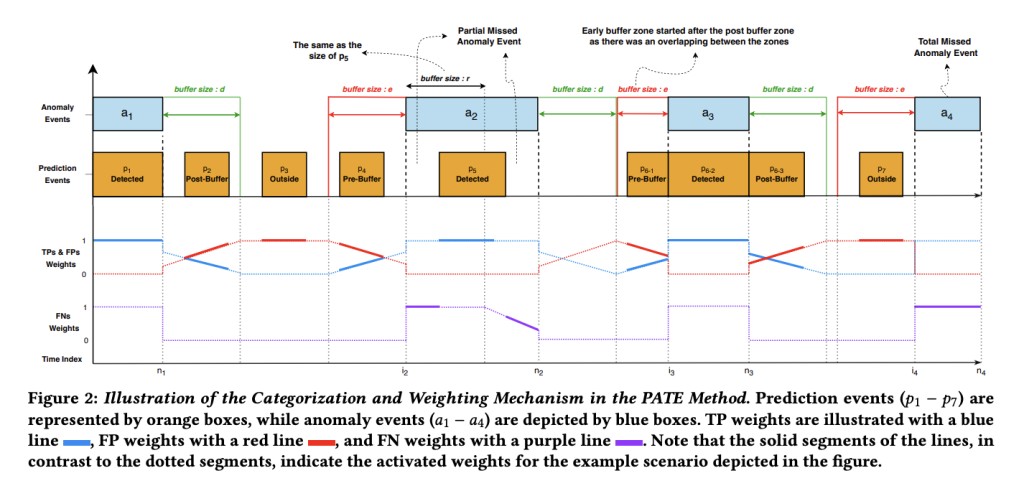Anomaly detection in time series data is a crucial task with applications in various domains, from monitoring industrial systems to detecting fraudulent activities. The intricacies of time series anomalies, including early or delayed detections and varying anomaly durations, are not well captured by conventional metrics like Precision and Recall, intended for independent and identically distributed (iid) data. This shortcoming might result in erroneous assessments and judgments in crucial applications like financial fraud detection and medical diagnostics. To address these issues, the study presents the Proximity-Aware Time series anomaly Evaluation (PATE) measure, which provides a more accurate and nuanced evaluation by incorporating proximity-based weighting and temporal correlations.
Time series anomaly detection is now evaluated using several metrics, each with limitations. The sequential structure of time series data has led to the development of metrics such as Range-based Precision and Recall (R-based), Time Series Aware Precision and Recall (TS-Aware), and the Point Adjusted F1 Score (PA-F1). However, these measurements either need subjective threshold settings or don’t fully account for onset reaction timing, early and delayed detections, or both. While threshold-free evaluations are provided by measures such as the Area Under the Receiver Operating Characteristic curve (AUC-ROC) and the Volume Under the Surface (VUS), they do not fully account for the temporal dynamics and correlations in time series data.
To fill these gaps, the researchers suggest a unique evaluation metric that offers a weighted version of the Precision and Recall curve. This comprehensive tool for evaluating anomaly detection algorithms incorporates several crucial elements, including coverage level, onset response timing, and early and delayed detection. The method assesses models by considering the temporal proximity of detected anomalies to genuine anomalies, categorizing prediction events into true detections, delayed detections (post-buffer), early detections (pre-buffer), and false positives or negatives. These categories are assigned weights based on their importance to early warning, delayed recognition, and anomaly coverage.
The study highlights the drawbacks of current metrics and introduces this new method as a reliable fix. By integrating buffer zones and temporal proximity, it enables a more thorough and precise evaluation of anomaly detection models, improving alignment with real-world applications where prompt and accurate detection is essential. The proposed evaluation metric considers temporal correlations between predictions and actual anomalies to provide a more comprehensive and transparent assessment of algorithms. True Positives, False Positives, and False Negatives are given proximity-based weights, making the model performance assessment more precise and insightful. Adapting to different buffer sizes without sacrificing consistency or fairness further demonstrates the method’s resilience and applicability.
Re-evaluation of state-of-the-art (SOTA) anomaly detection methods using this new metric reveals notable differences in performance assessments compared to other metrics. Point-adjusted metrics often overestimate model performance, whereas metrics like ROC-AUC and VUS-ROC, while more reasonable, may overlook subtle detection errors and lack discriminability between models. This analysis questions the true performance of current SOTA models and indicates a shift in their rankings, challenging the prevailing understanding of their superiority.
In conclusion, this novel approach represents a significant advancement in the evaluation of time series anomaly detection methods.The paper effectively identifies the shortcomings of existing evaluation metrics for time series anomaly detection and proposes PATE as a robust solution. Its incorporation of temporal proximity and buffer zones allows for a more accurate and nuanced assessment of anomaly detection models, ensuring better alignment with real-world applications where timely and accurate detection is crucial. Its potential implications include guiding future research, influencing industry adoption, and enhancing the development of practical applications in critical domains such as healthcare and finance.Â
Check out the Paper. All credit for this research goes to the researchers of this project. Also, don’t forget to follow us on Twitter. Join our Telegram Channel, Discord Channel, and LinkedIn Group.
If you like our work, you will love our newsletter..
Don’t Forget to join our 42k+ ML SubReddit
The post Evaluating Time Series Anomaly Detection: Proximity-Aware Time Series Anomaly Evaluation (PATE) appeared first on MarkTechPost.
Source: Read MoreÂ

